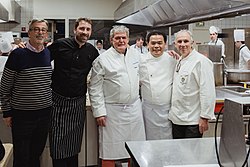烹飪外交


烹飪外交(Culinry diplomacy),又稱美食外交,為文化外交的一種,本身亦是公共外交的一部分。它的基本前提是「贏得人心的最簡單方法是通過胃」。 [1]新加坡、[2]泰國、韓國、馬來西亞、印度尼西亞、[3]秘魯、美國、 [4]柬埔寨、 [5]日本、 [6]斯堪的納維亞、澳洲和烏茲別克[7]已建立政府資助的官方烹飪外交項目。 [8]
例子
[編輯]柬埔寨
[編輯]
2020年12月,柬埔寨的外交與國際合作部正式啟動「2021-2023 年食品外交」活動,作為經濟外交戰略的一部分。該部還制定了一項培訓柬埔寨廚師在柬埔寨大使館服務的計劃,以及一項為大使配偶提供有關高棉美食知識的計劃。 [5]
2021年2月,該部更出版了一本食譜,名為《The Taste of Angkor》,作為柬埔寨駐外的外交使團之烹飪推廣工具。 [9]

中國
[編輯]1972 年在理查德尼克松訪華時,於人民大會堂舉行的宴會被形容為「美食外交和美食民族主義的信號時刻」,以及美食的「盛大的烹飪和外交表演」。 [10] (p. 56)及後,美國的《紐約時報》亦出版食譜,幫助讀者重現電視上看到的宴會菜餚。 [10] (p. 56)
印尼
[編輯]
印尼菜深受鄰國歡迎,當中包括馬來西亞、新加坡和澳洲,以及與印尼有着歷史淵源的國家(如荷蘭、蘇里南和南非),其亦開始在日本和韓國受歡迎。 [11] [12]2021年,印尼政府啟動了Indonesia Spice Up The World計劃, [3] [13]旨在向國外推廣印尼美食,透過幫助當地的香料產品和加工食品進入全球市場,以及幫助海外的印尼餐館。 [14]
Indonesia Spice Up The World計劃包含政府部門間機構、印尼食品工業和公眾。該計劃的目標是將印尼香料和草藥的出口價值提高到20億美元,並到2024年,在國外的印尼餐館增加4000家。 [3] [14]
新加坡
[編輯]近年來,新加坡通過其位於世界各國的大使館發起了一項烹飪外交倡議,以推廣新加坡美食。 [15]
2021年6月,南韓連鎖便利店CU宣布與新加坡旅遊局(STB)合作,作為其「新加坡美食之旅系列」的一部分,開始在其所有門店銷售新加坡菜咖椰吐司。 [16]
2021年10月,新加坡駐日本大使 Peter Tan 邀請當地組織到使館官邸進食新加坡菜,例如加東叻沙。
美國
[編輯]
2012年9月,美國正式啟動了「烹飪外交夥伴計劃」, [17]該倡議由美國國務院禮賓辦公室籌劃。白宮行政總廚Cristeta Comerford 、前白宮行政糕點師 William Yosses和出生於西班牙的廚師José Andrés等80多名廚師,皆被任命為「美國廚師團」的成員。該計劃的目標之一是派遣廚師團成員到美國駐外大使館教授美國美食,推廣外交。
參考文獻
[編輯]- ^ Rockower, Paul S. "Projecting Taiwan: Taiwan's Public Diplomacy Outreach." (頁面存檔備份,存於網際網路檔案館) Issues & Studies 47, no. 1 (March 2011): 107-152.
- ^ Culinary Diplomacy Served At Singapore Embassy. Asia Society. 2 April 2011 [3 February 2022]. (原始內容存檔於2022-02-03) (英語).
- ^ 3.0 3.1 3.2 Indonesia Spice Up the World, Homepage. Indonesia Spice Up the World. 2021-10-29 [2022-03-27]. (原始內容存檔於2022-01-13) (美國英語). 引用錯誤:帶有name屬性「Indonesia Spice Up the World」的
<ref>標籤用不同內容定義了多次 - ^ Chapple-Sokol, Sam. Culinary Diplomacy: Breaking Bread to Win Hearts and Minds. The Hague Journal of Diplomacy. 2013, 8 (2): 161–183 [2022-04-25]. doi:10.1163/1871191x-12341244. (原始內容存檔於2013-05-08).
- ^ 5.0 5.1 Siow, Maria. Cambodia is taking a pungent, potent approach to food diplomacy: prepare for prahok. South China Morning Post. January 3, 2021 [April 14, 2021]. (原始內容存檔於2022-04-25). 引用錯誤:帶有name屬性「Maria」的
<ref>標籤用不同內容定義了多次 - ^ Farina, Felice. Japan's gastrodiplomacy as soft power: global washoku and national food security (PDF). Journal of Contemporary Eastern Asia. 2015-08-03, 17 (1): 152–167 [2022-04-25]. doi:10.17477/jcea.2018.17.1.152. (原始內容 (PDF)存檔於2022-06-19) (英語).
- ^ Abduazimov, M. Gastrodiplomacy: foreign experience and potential of the republic of Uzbekistan. International Relations: Politics, Economics, Law. 2017-07-01, 2017 (2): 3–11 [2022-04-25]. ISSN 2010-6203. (原始內容存檔於2022-04-07).
- ^ The emergence of a New Nordic Food Culture: Final report from the program New Nordic Food II, 2010–2014 (PDF). Nordic Council of Ministers. 2015 [2022-04-25]. ISBN 978-92-893-4155-4. doi:10.6027/ANP2015-723. (原始內容 (PDF)存檔於2021-10-05).
- ^ Thmey, Thmey. Foreign Ministry Offers the World a Taste of Khmer Culture. Cambodianess. 6 February 2021 [17 May 2021]. (原始內容存檔於2022-04-25).
- ^ 10.0 10.1 Culinary nationalism in Asia. Michelle Tien King. London, UK. 2019. ISBN 978-1-350-07869-7. OCLC 1100471127.
- ^ Check Out Indonesian Food in Seoul: Lilin Indonesian Restaurant. KoreabyMe. 2021-05-12 [2022-03-27]. (原始內容存檔於2022-07-01) (美國英語).
- ^ Indonesian Food Popular among North Koreans. Tempo.co. 17 May 2015.
- ^ BeritaSatu.com. Oktober, Jokowi Akan Luncurkan "Indonesia Spice Up The World" dalam Expo Dubai. beritasatu.com. 2021-07-29 [2022-03-27]. (原始內容存檔於2021-08-03) (印度尼西亞語).
- ^ 14.0 14.1 Rochman, Fathur. "Indonesia Spice Up the World" to boost culinary industry: Uno. Antara News. 20 July 2021 [2022-03-27]. (原始內容存檔於2022-05-30). 引用錯誤:帶有name屬性「Antara-ISUW」的
<ref>標籤用不同內容定義了多次 - ^ Rajan, V K. Serving Singapore: My Journey. Chapter 20: Food in Diplomacy. November 2019 [3 February 2022]. doi:10.1142/9789811205583_0020. (原始內容存檔於2022-02-05).
- ^ 이재은. CU에서 떠나는 '싱가포르 미식여행'…칠리크랩·카야토스트 판매 - 머니투데이. news.mt.co.kr. 29 June 2021 [27 October 2021]. (原始內容存檔於2022-04-17) (韓語).
- ^ U.S. Department of State to Launch Diplomatic Culinary Partnership (頁面存檔備份,存於網際網路檔案館). 2012/1392
